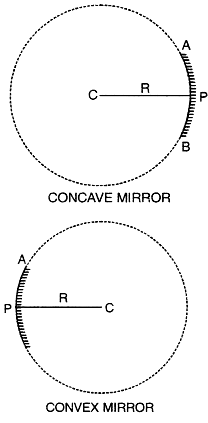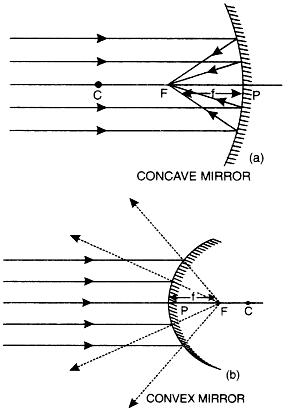(a) 1. A spherical mirror is a part of a spherical reflecting surface.
Two types of spherical mirrors are:
- Concave mirror, whose reflecting surface is towards the centre of the sphere of which the mirror is a part. (a).
- Convex mirror, whose reflecting surface is away from the centre of the sphere of which the mirror is a part; Fig. (b).
2. Centre of curvature: The centre of the sphere, of which the mirror forms a part is called the centre of curvature of the mirror.
It is represented by C [Fig. (a) & (b)].
3. Radius of curvature: The radius of the sphere, of which the mirror forms apart is called the radius of curvature of the mirror.

It is denoted by R. In Fig. and the distance PC = R represents the radius of curvature of the mirror.
4. Pole: The middle point of the spherical mirror is called its pole.
It is denoted by P (a) and (b)].
5. Principal axis: The line joining the pole and the centre of curvature of the mirror is called the principal axis of the mirror.
The line PC extended both ways in Fig. represents the principal axis of the mirror.
6. Aperture: The diameter of the mirror is called aperture of the mirror.
7. Principal Focus: It is a point on the principal axis where the rays of light parallel to the principal axis after reflection from the spherical mirror either converge to that point or appear to diverge from that point.
In case of concave mirror rays of light converge to point F, therefore, principal focus is real. In case of convex mirror, rays of light appear to diverge from point F, therefore, principal focus is virtual as shown in Fig. (c).

Focal length: It is the distance of the principal focus from the pole of mirror. It is denoted by f.
(b) Sign Conventions used in Spherical Mirrors
- All the distances are to be measured from the pole of the mirror.
- The distances measured in the same direction as incident light are taken as +ve.
- The distances measured in the direction opposite to the incident light are taken as -ve.